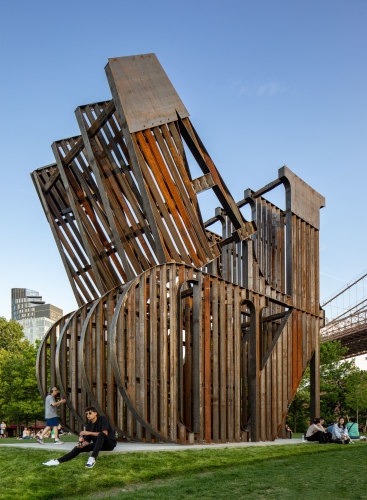
A New Brooklyn Sculpture Turns Pop Art on Its Head
By Maya Pontone
May 24, 2023
A new 30-foot sculpture unveiled last week at Brooklyn Bridge Park adopts the form of a famous Pop Art work to enact a sharp critique of colonial violence.
Created by Nicholas Galanin, the artwork’s bilingual title, “In every language there is Land / En cada lengua hay una Tierra” (2023), is a reference to the two imperial languages spoken on both sides of the United States-Mexico Border. Reminiscent of Robert Indiana’s iconic “Love” (1964), the steel sculpture reads “Land” in four layers of beamed text. The allusion to the iconic red symbol is a statement on how capitalistic mass marketing and pop culture can be weaponized as nationalistic propaganda.
Made out of corten steel — the same material used for the infamous wall that runs along the southern border — the 34,000-pound structure is a powerful message for Galanin’s first public artwork in New York City. It will remain on view at the 85-acre waterfront park until March 10, 2024.
“Pop Art was this movement that was critical of fine art and was ironic,” Galanin said. “This work is critical of control and exclusion, packaged in a form that’s accessible via familiar visual language and very specific materials. This work is not whimsical or nostalgic in any way that the text or pop art reference could suggest, so there’s an incongruity with the material.”
Moreover, whereas the rigid reality of border walls restricts movement, Galanin’s Brooklyn sculpture allows viewers to walk through, passing in spaces between the sculpture’s massive lettering. This freedom of movement is another allusion to Indigenous concepts of interconnected land and communities, harking back to the artist’s own Lingít-Unangax̂ heritage.
“These borders are directly connected and tied to settler colonization and the genocide and violence toward Indigenous people on Indigenous land,” Galanin told Hyperallergic.
His sculpture in Brooklyn currently sits on Lenapehoking, meaning “homelands of the Lenape,” which has its own history with border walls dating back to the 1600s. Then, Dutch colonizers constructed a wall around what was then New Amsterdam to force the Lenape people off of the island. This wall eventually became Wall Street.
While his newest work explicitly references the US-Mexico border, Galanin explained that “this work is relevant at any site on this continent” since everywhere has been affected by “these policies of exclusion and division.”
Based in Alaska, Galanin frequently revolves his art around how the lasting imprint of colonialism impacts Indigenous communities and land areas today. In 2021 for the Desert X Biennial in Palm Springs, he constructed “Never Forget” (2021), an alternative Hollywood sign that instead read “Indian Land” to put a direct spotlight on Indigenous land rights in the US and to raise funds for the Native American Land Conservancy. The project also involved calling on “settler landowners” to participate in LandBack, a movement that supports Indigenous sovereignty and the return of stolen land.
“Indigenous care for Land and community is rooted in connection based on mutual sustainability. Rather than nationalism or capital, this perspective always embodies a deep respect for life beyond any single generation,” Galanin said in a statement about his latest work.
“‘In every language there is Land / En cada lengua hay una Tierra’ questions barriers to Land, which directly reflect barriers to love, love for Land, community, and future generations,” he added.